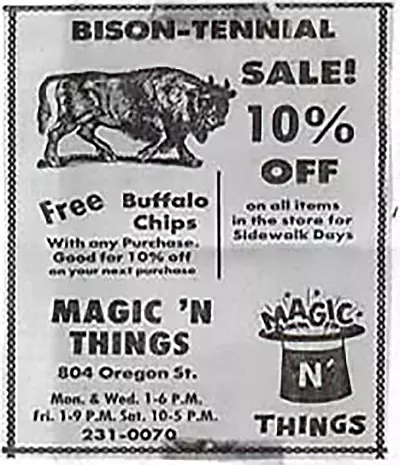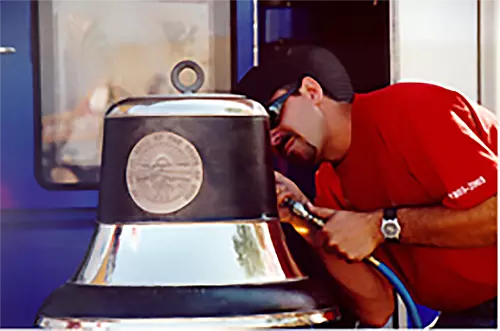"Another View of Ohio's Bicentennial": A Speech Given Before the Annual Dinner of the Lucas County-Maumee Valley Historical Society, June 11, 2003
by Timothy Messer-Kruse, Assoc. Prof. of Labor History, Univ. of Toledo [1]
Being a classroom lecturer I am accustomed to speaking extemporaneously but tonight I must break with old habits and read from my prepared text as I do not want to ramble on and force Chuck to get the hook and pull me from the podium. When I was offered the honor of speaking at the society’s annual dinner I quickly accepted before I had a clear idea of what it was I was going to talk about. (Accepting without thinking is one of the reasons I was recently elected chair of the history department.) I knew that my current research into the history of Toledo’s bank failures during the Great Depression was not a suitable topic for if presented thoroughly its procession of graphs and spreadsheets would be certain to bore and if not presented thoroughly would expose me to actions for slander. Better than such a potentially litigious subject, I figured I could safely find something to say about Ohio’s Bicentennial, not offend anyone, and escape without any lawyers becoming involved.
After spending the past few weeks researching Ohio’s Bicentennial, I think I am safe from the courtroom, though perhaps not from someone taking offense. If what I have to say does at points ruffle any feathers, I sincerely apologize and beg that those ruffled understand that no animus or ill-will is intentioned, and that my apparent lack of sentiment is motivated not by a deficiency of feeling for Ohio (even though it is a clearly established fact that Ohio is to blame for my home-state of Wisconsin losing the upper peninsula to Michigan) but is merely a byproduct of striving to view history in an objective light.
I’ve long been fascinated by public holidays and anniversaries. One of the most distinct memories from my own childhood is the U.S. Bicentennial celebration in 1976. This event is memorable for me partly because I had just 13, an age at which all shy boys desire most of all to be anonymous, especially in public. My parents owned a small novelty store which sold gags, clown supplies, and magic tricks—a whimsical business that my very outgoing father reveled in. Dad decided it would be good for business to join our city’s bicentennial parade and in keeping with the theme of his store found a way to make a joke at the same time. He rented a twelve-foot tall fiberglass buffalo that was bolted onto a trailer and draped a banner over its side saying “Happy Bison-Tenial”. My job was to ride on the trailer and toss coupons in the shape of buffalo chips to the crowds lining the street. I’m not sure how he persuaded me to do this, perhaps I figured it was better than the previous Christmas when I had to dress up as an elf with green leotards and curled toes and work as Santa’s helper at the local mall. Somehow I survived and this is my revenge.
The practice of observing centenaries of events with large publicly-funded ceremonies began in the mid-nineteenth century with the celebration of the one-hundredth anniversary of the signing of the Declaration of Independence in the summer of 1876. A massive international exposition was organized in Philadelphia underwritten by a 1.5 million dollar loan from Congress. Scores of monumental pavilions were constructed to house exhibitions from most states and from many foreign nations. Over that summer, an estimated eight million visitors walked the Philadelphia exposition grounds, about one in twenty Americans.
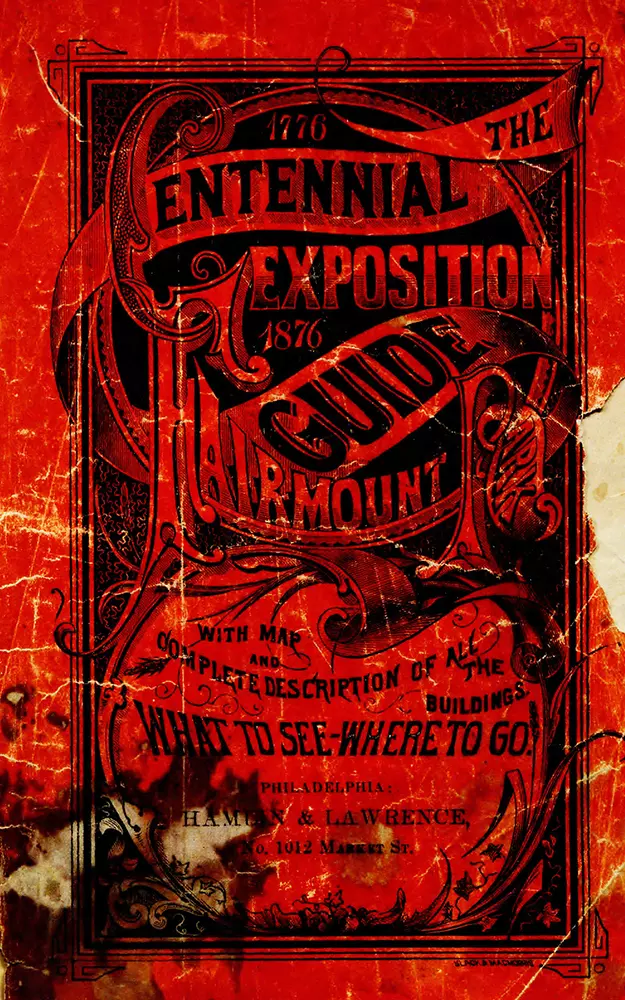 The Centennial Exposition guide, 1876 (Cover)
The Centennial Exposition guide, 1876 (Cover)
The Philadelphia Centennial Exposition was a huge success because it functioned perfectly as a psychic balm for the deep anxieties haunting the nation. The wounds of a devastating civil war were still fresh. The nation was still deeply divided over the nature of the political and social reconstruction of the South. On the grandest day of the exposition, the Fourth of July itself, as war veterans marched in honor of the birth of the nation, news arrived that six African Americans had been murdered by Klansmen in Hamburgh South Carolina, illustrating clearly the unfinished business of the war. The next day news arrived across the telegraph wires from the west that General Custer and his men had been defeated at Little Big Horn, illustrating the limits of American power. Industrialization was beginning to uproot and threaten traditional customs and patterns of work and community ties. Earlier that same year twenty-four Pennsylvania miners were tried for conspiracy to murder local officials and mine bosses and sentenced to death. Immigrants were beginning to pour upon American shores in record numbers from places increasingly foreign to Anglo-Saxon Protestant culture prompting Congress to debate placing racial restrictions on immigration for the first time. Not least of all, Americans were beginning to doubt the virtues of their government as President Grant’s administration was then embroiled in a series of scandals involving graft of whiskey taxes, the corrupt sale of federal lands, and bribery.
Plastering over these wounds was a centennial event that celebrated a fictional national unity, the universal goodness and progress of technology, and the divine perfection of American institutions.
![Colossal hand and torch "Liberty" digital file from original [stereograph] Colossal hand and torch "Liberty" digital file from original [stereograph]](https://toledosattic.org/images/jch-optimize/ng/images_exhibits_Bicentennial_liberty-arm-large-stereoscope.webp) Colossal hand and torch "Liberty" digital file from original [stereograph]
Colossal hand and torch "Liberty" digital file from original [stereograph]
Though one could find pieces of the exhibition that challenged these ideas - the abolitionist-financed statue commemorating emancipation or the unfinished hand and torch of the Statue of Liberty in the French exhibit – these were little noticed or commented upon at the time. Instead the massive Corliss Engine in Machinery Hall, symbolizing the unbridled power and progress of industry was most popular, as were the international exhibits whose presence gave Americans a sense of being noticed and respected by a larger community of nations.
The Philadelphia Centennial Exposition shows well the functions of centennial celebrations. They can provide a means of reasserting or even inventing a sense of historic community, creating the sense of a shared experience through time, and idea that somehow, in spite of all our differences and disagreements, we share a past and a future together. This is accomplished by enshrining a single event of the past as a “founding moment”, a moment whose importance and being extends from the past to the future through all members of the community. In Philadelphia the signing of the Declaration of Independence provided this seminal “founding moment” and was a means of erasing the bloody and deep divisions that split the nation North and South, rich and poor, native and immigrant, white, black, yellow and red. (See Lyn Spillman, Nation and Commemoration: Creating National Identities in the United States and Australia (Cambridge Univ. Press, 1997))
The problem is that the reality of these historic moments are not nearly as neatly unified and ideal as is their remembrance of them. For example, in 1921, America celebrated the tercentenary of the Pilgrim landing at Plymouth rock.
 Grand Finale of "The Pilgrim Spirit," The Tercentenary Pageant, Plymouth, Massachusetts. 1921
Grand Finale of "The Pilgrim Spirit," The Tercentenary Pageant, Plymouth, Massachusetts. 1921
Congress appropriated half a million dollars for the event and a long line of major political figures spoke at the seaside amphitheater built especially for the event. History was then a pastiche of myth and misrepresentation. The Pilgrims were depicted as enterprising, law-abiding, selflessly Christian though perhaps somewhat dour and overly temperate people. What historians tell us about their intolerant theocratic tendencies, their good fortune at landing at the site of an abandoned Indian village with corn still standing in the fields, their incessant bickering among themselves (they would become the most litigious community in America) or their typical pre-modern habits of life (Increase Mather wrote: “Drink is in it self a good creature of God, and to be received with thankfulness...” and among William Bradford’s possessions listed in his will were a couple of “great beer bowls”) was, of course absent.
Here the function of a Plymouth centennial celebration stands in stark contrast to its own history. Historians, by ruthlessly stripping away the layers of myth from the actual occurrences of the past have undermined the usefulness of these founding moments and thereby enfeebled the power of centennial events to spread an imaginary ideal of civic unity. Over the course of the Twentieth century the inclusion of minority voices into our mainstream political life has both broadened our sense of history and complicated its retelling. This progress in terms of our public knowledge and appreciation of history has as one unintended byproduct the rendering of public commemorative events less able to construct a past useful in promoting a sense of citizenship.
The disjunction between historical reality and commemorative ideal grows widest in times of crisis.
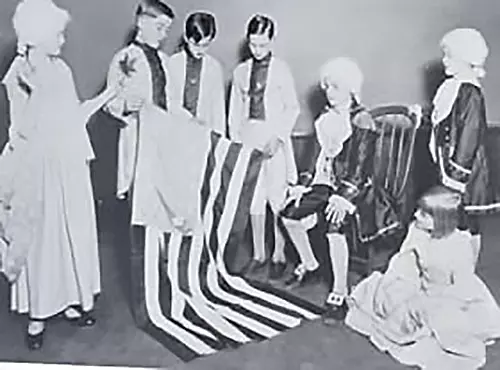 Preparing to observe the bicentennial of George Washington’s birth
Preparing to observe the bicentennial of George Washington’s birth
In 1932 Congress mandated that the nation observe the bicentennial of George Washington’s birth and no effort was spared in the event. Commemorative postage stamps, the planting of 35 million Washington centennial trees, the minting of the Washington quarter, the naming of the world’s largest suspension bridge for Washington, the building a replica of Mt. Vernon in Paris, France, a bicentennial baseball game, a bicentennial pigeon race, the compiling of all of Washington’s writings, a nation-wide Washington elementary school, declamatory contest, the commissioning of Washington dramas and the distribution of 160,000 play scripts to schools and civic organizations; the commissioning of songs from famous composers: John Philip Sousa composed one of his last works, “The George Washington Bicentennial March”; George M. Cohan, famous for his war tune, “Over There” composed “Father of the Land We Love”, and John Alden Carpenter composed “Song of Faith” for chorus and the distribution of millions of pamphlets, and each state and city coordinated its own celebrations.
But one of the most salient facts about Washington’s life and history was completely neglected in spite of all of this attention. The fact that he was one of the largest slave-owners in Virginia all of his adult life passed without mention. One of the only references to slavery I could find in the multi-volume compendium of the bicentennial commission is from a play intended to be performed by school-children entitled “Childhood Days in Washington’s Time”, in Act III, “The Possum Hunt” young Washington is out in the woods with his friend Dickey Lee:
Dickey Lee (in a frightened voice): Whats that over in that shadow? I saw some one moving.
George (to the shadow) Here you, come here. ((Little) Peter comes toward them) [the script says that Little Peter’s costume should include “a black stocking pulled over the head like a cap and covered with tufts of black curled hair to make a wig. The face, neck, arms, hands, legs and feet should be blackened...”]
What you mean spying on me and tagging after me this time o’night? Take that (He gives the little darkey a slap across the face, who falls down and lies motionless at his feet.)
Dickey Lee: George, what have you done? Your so strong.
George: If we only could see. Hey Peter, come to life; quit your fooling.
Dickey Lee: He’s playing possum, I do believe. Let’s shake him good.
Peter: (Opening his eyes and grinning.) – You hits mighty hard, Marse George. (History of the George Washington Bicentennial Celebration (Washington, 1933), vol. 2, p. 658.)
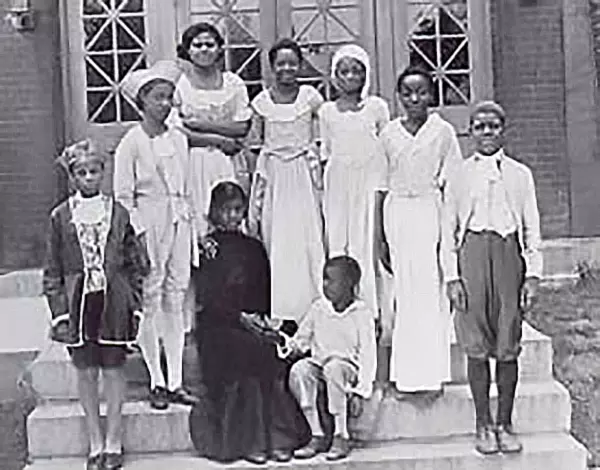 Washington Pageant at African-American School
Washington Pageant at African-American School
Except for this bizarre glorification of Washington the strong master, the 1932 festival gloried in an uncomplicated Mason Weems version of the mythic hero Washington. In 1932, when the nation was racked by the worst economic depression in its history, with Jim Crow at its height in the South, with veterans staging a massive protest in the capital and with the political system undergoing a historic shift towards Democratic control, the nation rushed to embrace the an image of national unity, even if this symbol implicitly excluded a large proportion of the population from the notion of citizenship.
The changing nature of centennial commemorations is well illustrated in Ohio’s public observances of its own anniversaries. This year marks the third time that Ohio has celebrated its founding. Each of these commemorations, spaced as they were at the beginning, the middle, and the end of the Twentieth Century, are telling symbols of their age. Each affords a little glimpse beneath the bare facts of history to reveal something of the spirit of the time, for the way we remember events reveals not only what we value but how we understand our ourselves.
Ohio’s first Centennial celebration fell far short of its organizer’s expectations. Toledoans successfully lobbied to have their city designated as the site for a grand Ohio Centennial Exposition that they hoped would propel their city to world prominence. Toledo’s boosters planned to pour over a million dollars into construction of a grand exposition grounds at Bay View Park, enough to compete with St. Louis’s Louisiana Purchase Fair whose budget was five million. But, as often happens in Ohio history, party politics intruded with a fight between the Foraker and Hanna factions of the Republicans dooming the Toledo Centennial idea and ultimately settling for a far more modest ten thousand dollar observance at Chillicote. (Randolph C. Downes, "Toledo and the Ohio Centennial of 1902" Northwest Ohio Quarterly 25:4 (Autumn 1953) p. 189.)
On first glance, Ohio’s Centennial observances of 1903 appears out of proportion to its prominence as a state. In 1903 Ohio possessed the third largest number of farms in the nation, was fifth in value of manufactures, and fourth in population. The last elected President and the sitting vice-President were both Ohioans. The state was at the peak of its power and prosperity, yet the scope of its centennial observance was limited to a two- day commemoration in its twenty-second largest city.
A crowd less than half the size of Chillicote’s own population of thirteen thousand people attended the ceremonies which were heavy with solemnity and reverence. Most of the program consisted of prayers and invocations and scholarly lectures on Ohio history punctuated occasionally by a brass band striking up patriotic airs. The whole was a numbing blend of the elements of a protestant tent revival, a traveling Chautauqua, and a political campaign rally without the whiskey.
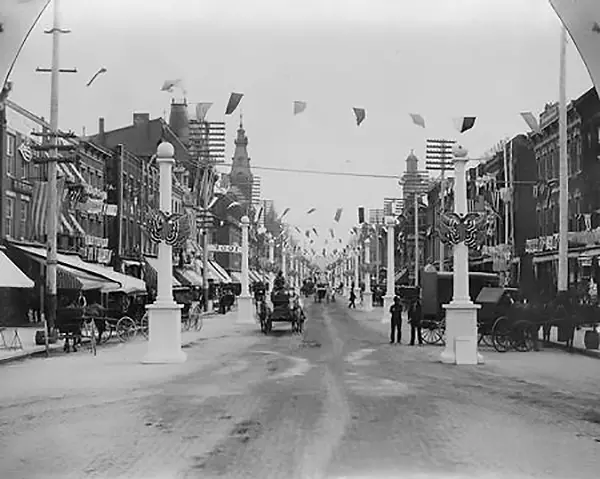 Chillicothe decked out for the state bicentennial.
Chillicothe decked out for the state bicentennial.
Though a low budget operation, Ohio’s centennial had all the elements of a unifying centennial. Governor Nash proclaimed that its purpose was for the “commemoration of its great deeds and the lives of its founders [so that they] may be not only perpetuated for the benefit of generations to come, but may be a source of inspiration to the living of to-day.” Feb. 27 was designated Ohio Day and each school classroom in the state followed an official “Ohio Centennial Syllabus” which was mailed to all 15,000 school teachers. It was filled with 65 pages of “drill and recitation” that was “well calculated to stimulate and strengthen study of the growth and achievements of Ohio.” (Ohio Centennial Anniversary Celebration at Chillicothe... E. O. Randall, ed. (Ohio Historical Society, 1903.)
The centennial events in Chillicote mixed raised state citizenship to the level of a secular religion by beginning even each round of academic lectures with a prayer and patriotic song. It successfully connected present with past by inviting onto the rostrum the men who had direct memories of the early settlement days.
William T. McClintock, an eighty-three year old life-long resident of Chillicothe understood his own role: “I have said that I feel myself to be a connecting link between the past and present and so I am for I have personally known all the governors of the state from Edward Tiffin to our present governor. . .” McClintock noted that he followed the procession which carried Gov. Worthington to his grave in 1827. He then had to scrape a little to find something to say about Ohio’s first governor. “I had the honor of having a tooth pulled by Dr. Edward Tiffin in my childhood . . . a recollection . . as fresh as if it happened yesterday...”
Over all, the speeches and historical presentations of 1903 stressed a common Ohio origin by overlooking the divisive and stressing only the unifying elements of the state’s history. Of course, unmentioned were the rancorous debates in the original Constitutional convention over race, taxation, and native American relations, bitter issues which if mentioned, give the lie to the idea of a unified founding moment. No discussion was made of the struggles of working people and immigrants in the state; somehow canals dug themselves, coal tumbled out of the earth and capital alone worked the factories. Ohio was not discussed as the cradle of the abolitionist or temperance movements, perhaps the most divisive political movements in the nation’s history.
In 1953 Toledo took the initiative in organizing a celebration of Ohio’s sesquicentennial. With a $32,000 appropriation from the city and county and $46,000 from private companies the sesquicentennial organizers swung into full gear. Walbridge park and the zoo were designated “Sesqui Center” and a month-long series of events centered around the Fourth of July were planned. There was a gala Sesqui-ball at the Commodore Perry Hotel at the princely sum of $10 per plate. Out at the Sesqui Center there was a Sesqui-tent filled with among other things, artwork produced by children who participated in an Ohio birthday art competition. There was a historic “village of pioneers” who represented life on the frontier and the “winning of the west”. The military put on a display of some of its latest equipment.
But the centerpiece of Toledo’s sesquicentennial celebration was the grand “Sesqui-show” written, and performed by over one hundred local talents, including a then as yet undiscovered Danny Thomas. Put on in the zoo bandshell it was a grand evening that dramatized Ohio and Toledo’s history from Act One and the “First Settlers” singing the “Indian Epilogue” and “Sweet Betsy of Pike” to its finale entitled “The Industrial Parade and Ohio Hall of Fame”. Interestingly, the writers choose to explore history only up through the 1920s with the performance in Act II of the Charleston and star Lanny Ross singing “The Showboat.” Apparently no one wanted to remember the more recent events of the Great Depression or World War Two. All in all, it was a fantastic success with a quarter million visitors and ticket income exceeding expenses (how often does that happen in historical events?)
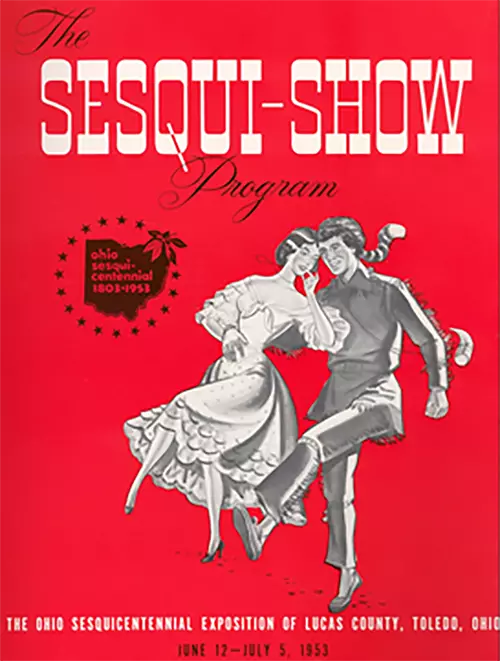 Ohio Sesquicentennial: Toledo, Ohio 1803-1953, Toledo Chamber of Commerce, 1953
Ohio Sesquicentennial: Toledo, Ohio 1803-1953, Toledo Chamber of Commerce, 1953
Like the centennial of 1903, Toledo’s sesquicentennial was built on a romantic and uncomplicated view of history. As the program to the Sesqui-show proclaimed, “It is designed to strike a note of respect and reverence appropriate to the heritage of moral and physical strength handed down by the pioneers and their successors to the Ohioans of today.” For a generation just emerging from depression and world war and entering a new and in some ways more dangerous time of thermonuclear cold war, such a vision of blissful civic consensus was just what they wanted to celebrate.
In the half century since 1953, much has changed, not least is our public sensitivity to the variety of historical experiences of Americans. In the wake of the Civil Rights movements of the 1950s and 1960s, after Roots, after Cesar Chavez, after the occupation of Wounded Knee and Alcatraz, after decades of activism of people from all over the country who discovered deep meaning in histories that emphasized conflict and struggle, oppression and liberation, we emerged in the twenty-first century as a people who can no longer easily romanticize our own past. No longer can the state celebrate an uncomplicated, consensus history because too many groups contest and challenge it. It cannot dare to celebrate some aspect of the past without fear of offending someone’s very different understanding of it.
In 1989 the Ohio legislature changed the words to the state song “Beautiful Ohio” removing from it the words:
Drifting with the current down a moonlit stream
While above the Heavens in their glory gleam
And the stars on high
Twinkle in the sky
Seeming in a paradise of love divine
Dreaming of a pair of eyes that looked in mine
Beautiful Ohio, in dreams again I see
Visions of what used to be.
Replacing it with:
Beautiful Ohio, where the golden grain
Dwarf the lovely flowers in the summer rain.
Cities rising high, silhouette the sky.
Freedom is supreme in this majestic land;
Mighty factories seem to hum in tune, so grand.
Beautiful Ohio, thy wonders are in view,
Land where my dreams all come true!
Thus in 2003 the state is celebrating a bicentennial that is largely stripped of its traditional didactic and unifying elements. Governor Taft’s signature quote gracing the top of the OHIO200.org website is “Ohio’s Bicentennial is a time to reflect on our past, to visit events and attractions celebrating the present, and to dream about our future.” This is a long way from Governor Nash’s understanding of his centennial the “commemoration of [the] great deeds and the lives of its founders [so that they] may be not only perpetuated for the benefit of generations to come, but may be a source of inspiration to the living of to-day.” (Ohio Centennial Anniversary Celebration at Chillicothe (Ohio Historical Society, 1903)) We are no longer told to extol the founders but merely to reflect on them. We celebrate the present and not the past and we dream not about history but about the future.
While centennials of the past may have been historically inaccurate, even biased to a large degree, their romanticized fictions did lend them a degree of spirit and vigor that I find absent today. Could we imagine a headline in a turn-of-the-century account of Ohio’s centennial celebration like that which appeared in the Blade this past March: "Ohio's constitution: Scribbled in haste in a Chillicothe pub"?
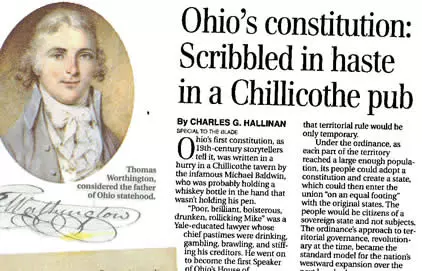 Ohio's Constitution; Scribbled in Haste in a Chillicothe Pub
Ohio's Constitution; Scribbled in Haste in a Chillicothe Pub
Or would any previous generation have considered creating a bicentennial mascot bird named for Thomas Worthington anything but irreverent?
 Bicentennial mascot bird named for Thomas Worthington
Bicentennial mascot bird named for Thomas Worthington
Take one of the signature events of our bicentennial, the casting of county bells. Bells are a complex symbol, denoting both the liberty bell and political freedom, the steeple bell and religious piety, and the school house bell and secular education. But as religion and, to an extent, even education, are controversial subjects today, these symbolic aspects of the bells are not mentioned. We are not invited to look upon the bells and consider Ohio’s historic role in religious revivalism that played such a part in the early life of the state, or to look upon the bell and consider the rural one-room schoolhouse through which the likes of Thomas Edison was educated. But these are complicated and potentially controversial historical subjects so instead the bells are explained officially as being “a thematic tribute to the state's manufacturing and industrial roots”. Gov. Taft after dedicating one of the bells explained, “It educates people of all ages about bell foundry work, which is an important part of our state’s manufacturing and industrial roots.” In fact, the numbers of bell foundry workers in Ohio was never even large enough to merit a separate category in the census tables.
But the real test of the exhortative function of celebrations is what children are told. My fourth grade son brought home a binder of materials dealing with the bicentennial this past year and I was most intrigued by the official bicentennial book distributed to children, “Happy Birthday Ohio.” A book that begins with a letter from the governor addressed to “Dear Young Ohioan” urging him or her to “share [this book] with your family and friends” and even to “pass this book down to future young Ohioans” as you grow older. In its chapters the young Ohioan would find the state bird, tree, flower, some Ohio firsts, a poem about “Little Buckeye” growing up, and the story of “Marblehead Muffler Man” who finds an invitation to a bicentennial celebration and gives up his job holding up a billboard to go to the states birthday party. Along the way he visits important state locations like the giant fiberglass apple in Port Clinton, the world’s largest basket in Newark, the 25 foot tall rocking chair in Austinburg, and other places. Within “Happy Birthday Ohio” there are no references to any historical events or to that traditional glue of civic unity, a “founding moment”.
All of this makes sense, I suppose in our modern society where today one quarter of Ohioans are not from Ohio and about one in twelve have not lived here more than five years. It makes sense in a state where nearly half of all its growth since 1990 is due to increases in the Hispanic and African-American populations. It makes sense in a global village of a world where one’s identity with a particular nation or state or place is not ones primary identity or even one’s permanent identity. The simple fact is that official civic history is no longer acceptable and the idea of celebrating any single “founding moment” is difficult at best.
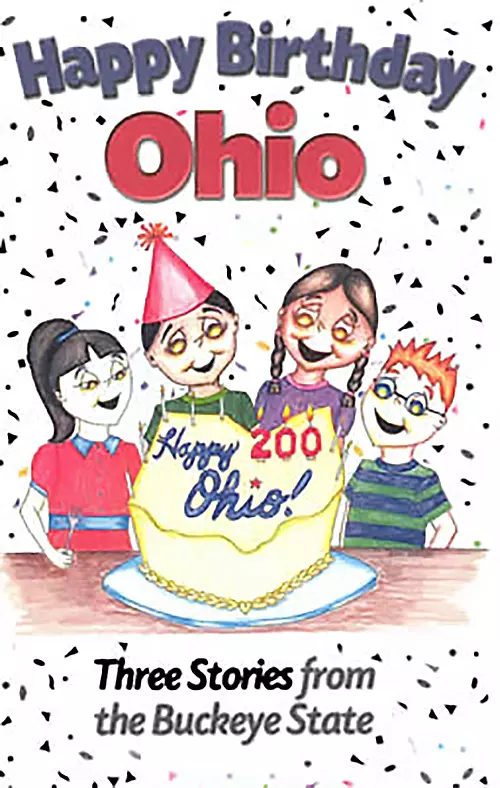 Children's bicentennial book: “Happy Birthday Ohio.”
Children's bicentennial book: “Happy Birthday Ohio.”
What we are left with is not one official story, but many stories, that woven together form the tapestry of our collective experience. In the past year, the best and most important work has been done by the local historical societies and local bicentennial organizing committees who have recognized important events in the lives of their own communities through public programs, historical markers and roadside signs. Though it lacks the grandeur of historical celebrations of the past, the devolution of official state history to local and community groups has made an opportunity for the presentation of a more accurate and relevant history.
[1] Note: All views expressed in this essay are those of Prof. Messer-Kruse and do not necessarily reflect the views of LC-MVHS, its officers, or employees.

